#bidri ware
Text
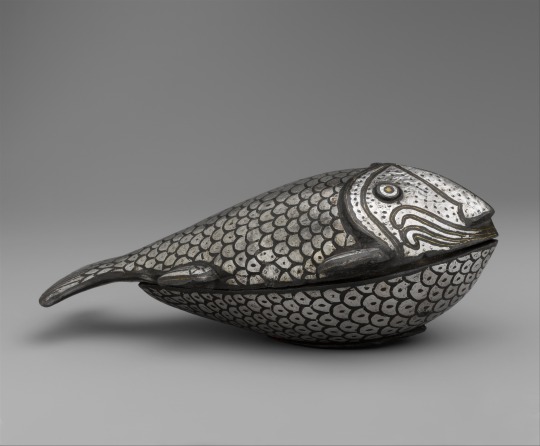
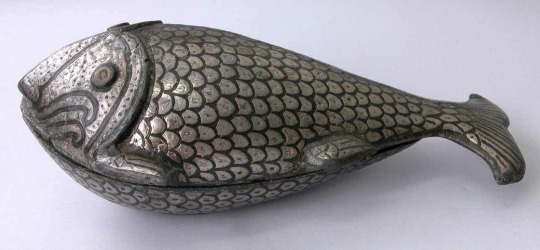
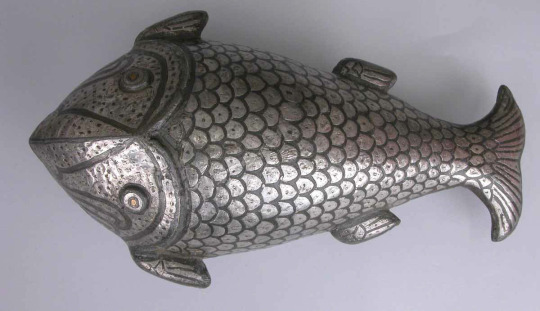
#FishFriday:
Fish-Shaped Box
Probably made in India, Lucknow or Hyderabad, 19th c.
Zinc alloy; cast, engraved, inlaid w/ silver & brass (bidri ware)
L 9 1/4 in (23.5 cm)
The Metropolitan Museum of Art, New York 19.135.15a, b
“Although the technique of inlaying metal known as bidri was invented in the Deccan in the 17th century, and Hyderabad remained a center for this type of metalwork into the 1800s, Lucknow, in northeastern India, also became an important center for production of bidri ware in the 18th and 19th centuries.”
#animals in art#fish#metalwork#bidri ware#Indian art#South Asian art#19th century art#box#effigy vessel#Metropolitan Museum of Art New York#Fish Friday
351 notes
·
View notes
Text

“A high-necked jar in Bidri ware”
9 notes
·
View notes
Text
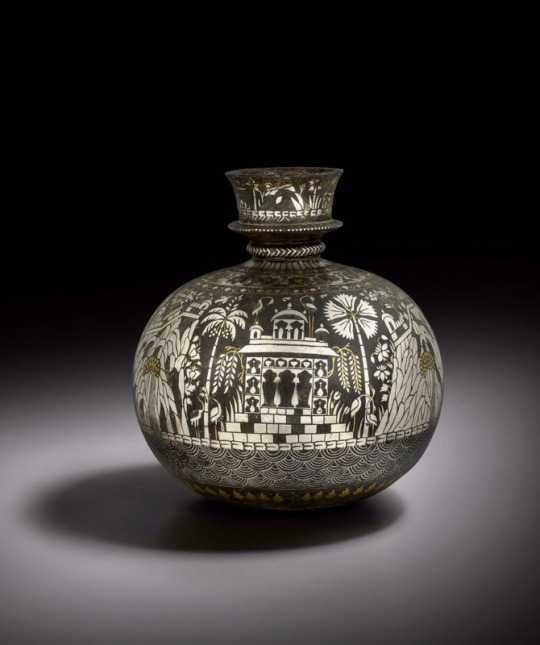
India, Huqqa Base with Landscape, mid-17th century, zinc alloy; cast,
engraved, and inlaid with silver and brass (bidri ware).
Courtesy Alain Truong
14 notes
·
View notes
Text



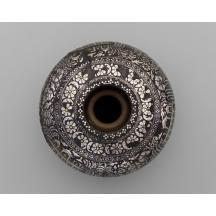
Luxuriant plants, elegant architecture, and charming animals grace this silver-inlaid water pipe base. The complicated techniques used to produce such sumptuous objects were developed by expert artisans in the Islamic kingdoms of south central India. The tradition was called Bidri ware after the city of Bidar in the area. Bidri water pipe bases were probably first produced shortly after tobacco was introduced into India by Portuguese traders in the late sixteenth century.
The pavilions seen here recall chini khanas, or “china rooms,” popular architectural features during the Mughal period in north India (1526–1858). Their multiple niches were used to display objects such as Chinese porcelains, which were highly prized at South Asian courts.
Asian Art Museum Chong-Moon Lee Center for Asian Art and Culture
27 notes
·
View notes
Photo

Bidri Ewer (Aftaba) India 18th century
10 notes
·
View notes
Photo

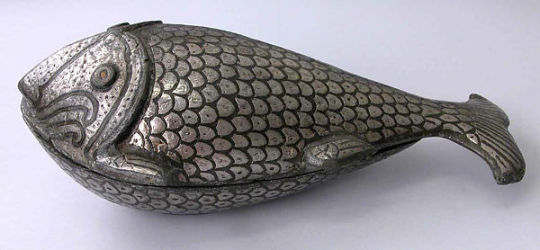
Fish-shaped box (bidri ware) made of dark zinc alloy with traces of iron and other metals, inlaid scales are polished silver alloy. 9.25 inches long
Made in northeastern India (Hyderabad or Lucknow), 19th century
Source: Met Museum
96 notes
·
View notes
Photo
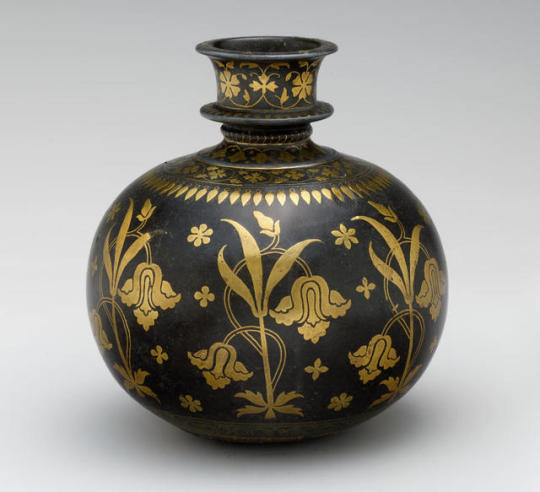
MWW Artwork of the Day (8/17/19)
Unknown Deccan artist (India, late 17th c.)
Base for a Water Pipe (Huqqa) with Irises (c. 1680-95)
Zinc alloy; cast, engraved, inlaid with brass (bidri ware), 17.5 high
The Metropolitan Museum of Art, New York
Of the small number of known bidri objects that predate the eighteenth century, a majority are huqqa (water pipe) bases. Tobacco arrived in India sometime in the late sixteenth century, brought by the Portuguese from the New World to the port of Goa. The plant acclimatized well, and its popularity soon spread from the western Deccan northward into Mughal territories. By 1620 tobacco was used all over, and while coconut shells were first employed as the hot-water chamber for the pipe, sometime around the mid-seventeenth century Bidar craftsmen were creating huqqa bases that rank among the most attractive decorative objects of the period. These early examples are nearly always spherical, though one or two ovoid examples are known. To remain stable, the base would rest on a bidri ring; with very rare exceptions, the rings seem to have all been lost. They would have been highly prized possessions of the Deccani rulers and their courtiers, or of the Mughal and Rajput aristocracy who arrived with the Mughal armies that gradually conquered the Deccan from 1636 to the end of the century. (from the MMA catalog)
1 note
·
View note
Photo

Container, Bidri-ware, 18th century, Brooklyn Museum: Asian Art
Size: 8 3/4 × 10 7/8 in., 11 lb. (22.2 × 27.6 cm, 4.99kg)
Medium: Copper alloy inlaid with silver decoration
https://www.brooklynmuseum.org/opencollection/objects/154351
11 notes
·
View notes
Text
Crafts of India

INDIAN HANDICRAFTS: KNOW ABOUT VARIOUS CRAFTS OF INDIA
From time immemorial, the crafts of India are known and praised worldwide. India has a vast cultural heritage that is reflected within the sophistication of its varied craftworks. The skilled artisans have managed to survive and uphold our heritage by creating exclusive pieces of art that reflects the influence of various empires on the works from our different states.
POTTERY
Known as one of the oldest and most beautiful forms of decoration, the tradition of pottery making dates back to the times of Indus Valley Civilization. Decorated pots have been used in all walks for a multitude of purposes. Pottery can be both handmade and wheel-made.
Figurines of religious importance, various artefacts, toys, dolls, pots, vases made of terracotta from Assam, Odisha, Keonjhar and Khurda; painted black wares from Uttar Pradesh; painted pottery with geometrical patterns from Bikaner and Pokhran in Rajasthan and Kagzi pottery from Alwar; the most famous blue pottery (wherein the blue dye is used to colour objects) from Jaipur and works from states of Tamil Nadu, Himachal Pradesh and West Bengal are some of the worth mentioning names.
JUTE
Widely known as the golden fibre, Jute comes second to cotton in terms of production in India. An extremely flexible fibre, it is turned and twisted easily to make a variety of articles. For centuries, jute has been an integral part of the culture of West Bengal, Assam and Bihar.
LEATHER
The leathercraft started perhaps during the times of Indus Valley civilization where the artisans mainly engaged in the making of clothes, footwear, caps, bags, saddles, shield, etc. The leather shoes, bags, garments, etc from Madhya Pradesh and the famous Kolhapuri chappals from Maharashtra are known all across the world.
METAL CRAFT
Metal crafts in India also originated during the Indus Valley Civilization. The statue of the Dancing Girl, bronze statues of the Chola kingdom and the iron pillar erected by Ashoka’s, the great, all witness our rich legacy in metal craft. Besides creating mythological figures and deities, other items include metal pots, pans, frames, locks, key chains etc.
The famous metal craft includes Bidri ware of Andhra Pradesh; Pembharti from Warangal district in Telangana; Dhokra metal craft from Andhra Pradesh, Odisha and Madhya Pradesh; Kamrupi metal craft from Kamrup, Assam. Made from brass and bell metal the items produced by this metal craft are pots, bowls, water pots, cymbals etc. The region of Ladakh is famous for its brass and iron vessels and the Kashmir is known for its naquashi work.
STONEWORK
Stonework has always fascinated all since long. The intricately carved palaces, forts and temples where various forms of carving, engraving, sculptures and undercuts are done on stones. The rock and marble carvings from Rajasthan, Jaipur, Odisha and Nagpur; the stoneware from Madhya Pradesh includes household items such as chakla, silbatta, handis, chakkis, etc. Gwalior, Ratlam, Mandsaur are famous for sculptures and figurines of religious importance. Pattharkatti in Gaya, Bihar is known as the village of stone carvers where the artisans churn out beautiful pieces made from black stone (granite). The ancient temples of Odisha and Khajuraho are world-famous examples of rock crafts of India. Marble ware from Agra in Uttar Pradesh owes its credit to the famous Taj Mahal.
NEEDLEWORK
The rich craft of India is incomplete without the mention of the famous thread and needlework from the different states of our sub-continent. The chikankari from Lucknow, crewel embroidery from Kashmir, applique work from Rajasthan, mirror embroidery from Gujarat and Rajasthan, kantha embroidery from West Bengal, phulkari from Punjab, Zardozi from Uttar Pradesh. Today these works are not limited to clothes but shawls, pillow and cushion covers, dupattas, home furnishings, bags, bedspreads, wall hangings are all in high demand.
WEAVE CRAFT
India has a rich and diverse weaving tradition. Be it fabrics made out of silk, cotton, or wool, the demand is never-ending. Silk saris, namely the Baluchari of West Bengal and Mooga and Assam silk of Assam, famous Banarasi saris, Kanchipuram, and Pochampalli saris from Tamil Nadu, Paithani from Maharashtra are among the finest saris in India. Among the cotton work, Khadi and kalamkari continue to dominate the market even today. Wool work is best when it comes to Pashmina shawls from Kashmir and Kullu shawls from Himachal Pradesh.
GI location crafts in India
The Indian traditional crafts have been diminishing in the current times. In order to protect our precious craftworks and the associated cultural heritage, GI tag is conferred on the handicrafts. The tag is used on products which corresponds to a specific geographical location from where they originated. The Government of India enforced the Geographical Indications of Goods (Registration and Protection) Act in 1999, which came into force in 2003. The GI tag confirms the product is made with specific standards and provide proprietary rights to the traditional producers and encourage them to make and sell authentic products. Today more than 150 handicraft products have been added to the GI list. The most popular ones include:
Geographical Indication State/UT
Pochampalli Ikat Telangana
Chanderi Saris Madhya Pradesh
Mysore Silk Karnataka
Bidriware Karnataka
Kullu shawl Himachal Pradesh
Channapatna toys and dolls Karnataka
Phulkari Punjab, Haryana & Rajasthan
Kashmir Pashmina Kashmir
Thanjavur paintings Tamil Nadu
Kani shawl Jammu & Kashmir
Nakshi Kantha West Bengal
Blue pottery of Jaipur Rajasthan
Bastar Dhokra Chattisgarh
Kutch embroidery Gujarat
Lucknowi Chikankari Uttar Pradesh
Sanganeri hand block print Rajasthan
Kota Doria Rajasthan
Warli painting Maharashtra
Kolhapuri chappal Maharashtra
Temple jewelry of Nagercoil Tamil Nadu
Durgi stone carvings Andhra Pradesh
Orissa Pattachitra Odisha
Patola Sari Gujarat
Banaras brocades and saris Uttar Pradesh
Lucknowi Zardozi Uttar Pradesh
Bobbili Veena Andhra Pradesh
Kashmir paper machie Jammu & Kashmir
Toda embroidery Tamil Nadu
Leather toys of Indore Madhya Pradesh
Nirmal toys and craft Telangana
Salem silk Tamil Nadu
Sikki grass products of Bihar Bihar
Khatwa work of Bihar (Applique) Bihar
Indian handicrafts online
4 notes
·
View notes
Photo

Bidri Box for Holding Pan, Islamic Art
Medium: Zinc alloy; cast, engraved, inlaid with silver and brass (bidri ware)
Louis E. and Theresa S. Seley Purchase Fund for Islamic Art and Rogers Fund, 1996 Metropolitan Museum of Art, New York, NY
http://www.metmuseum.org/art/collection/search/453366
3 notes
·
View notes
Text
#FishFriday:

Plate with Emblematic Pairs of Fish (mahi-ye maratib)
India, Uttar Pradesh, Awadh, Lucknow, c. 1880
Bidri-ware (zarbuland technique)
D: 6 3/4 in. (17.15 cm); H: 1/2 in. (1.27 cm)
LACMA M.2001.100
“The primary decoration on this bidri ware plate is a pair of fish arranged head-to-head with their curved bodies forming a circle. Known as the mahi-ye maratib (Fish of Dignity), it was an insignia of exalted rank that the Mughal emperors and earlier Middle Eastern rulers bestowed upon their subordinate chieftains in recognition of valorous military service. In 1720 it was awarded by the Mughal Emperor Muhammad Shah (r. 1719–48) to Saadat Khan, the Governor of Akbarabad (Agra), who soon became the Governor of Lucknow from 1722 to 1739. The fish emblem subsequently served as the dynastic leitmotif of the Lucknow court and was frequently displayed on its decorative arts and palatial architecture. It was represented in state processions as a fish and two gilt globes carried on a standard. A heraldic form consisting of a pair of honorific mermaids bearing a crown and flanking a shield was used as the personal coat of arms of King Wajid Ali Shah (r. 1847–56). Bidri ware is made from a predominately zinc-based alloy, along with smaller amounts of lead, copper, and/or tin. The ornamentation of bidri ware from the Deccan and eastern India typically features inlaid silver sheet or wire designs, which are rendered flush and burnished. Lucknow bidri ware is distinctive in that it is often executed in bold relief (zarbuland technique), in which the inlaid metals are allowed to remain protruding slightly above the surface and are then adorned with sheet overlay and incised motifs.”
#animals in art#19th century art#metalwork#animal emblems#fish#Fish Friday#Indian art#South Asian art#Asian art#colonial art#Bidri ware#LACMA#plate
8 notes
·
View notes
Photo
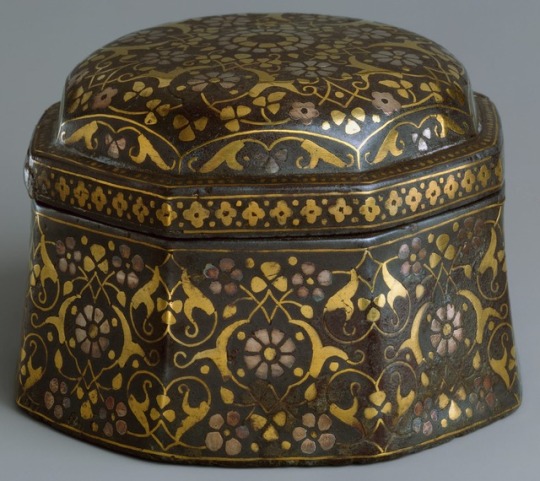
Bidri Box for Holding Pan Object Name: Box Date: early–mid 17th century Geography: Attributed to India, Deccan, Bidar Medium: Zinc alloy; cast, engraved, inlaid with silver and brass (bidri ware)
1 note
·
View note
Photo
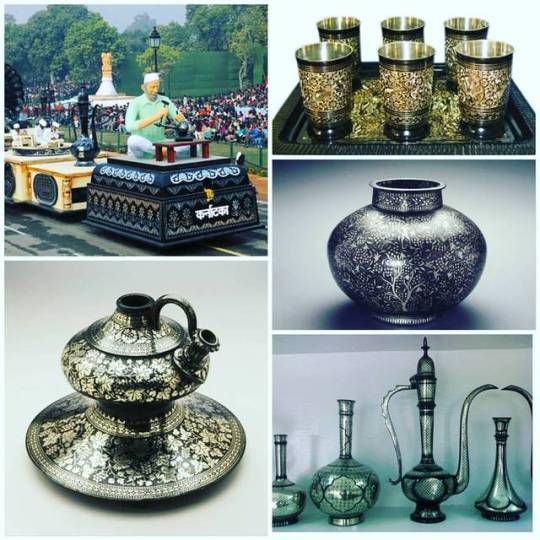
Bidriware ಬಿದ್ರಿ ಕಲೆ is an important export handicraft of India and is prized as a symbol of wealth. The metal used is a blackened alloy of zinc and copper inlaid with thin sheets of pure silver.This native art form has obtained Geographical Indications (GI) registry. GI in Karnataka has the highest no of GI locations then anywhere in India.🙆 👆👆👌👍🌍🌎🌏🎫🔍 Bidriware is the popular form of metal ornamentation reflecting their skills. Bidar District of Karnataka. It is a popular art form among South Indian handicrafts consisting metal ware of different sizes and shapes. It is generally manufactured using an alloy of 94% zinc and 6% copper. Developed in Bahmani Kingdom, it was a blend of local styles of Turkey, Persia, and Arabic countries. It did not die with the kings. It was patronized by successor kings. According to a prominent Indian handicraft manufacturer, this art was introduced by the Nizam of Hyderabad in Aurangabad since it was part of his kingdom then. To make the basic structure of metal Indian handicrafts, an alloy of zinc and copper is used. In old time, it was used for manufacturing vases, but now it is used to make boxes for ornament, jewelry, bowls, earrings, trays, and various show piece items. Since these are made from zinc, so their color is black. After casting, these are smoothened and then, a planned design is engraved. After this, silver wires or sheets are placed into these. These are polished and oxidized after inlaying of silver. Various flowers, leaves, human and geometrical figures are commonly found on these. Nowadays, various handicrafts exporters are manufacturing and selling these due to demand in the western countries. 📝📋🗿 In conclusion, Bidri work is a popular and elegant art form that is used widely in Indian metal handicrafts. ☑🔰 coming🔜📁📂📋📃📰 more 35 Geographical Indications of Karnataka Land of culture art temples heritage and history . Bit of piece of land has historical importance. (at Bidar Fort)
0 notes
Photo

Spherical Hookah Base MTW 1588
Mughal India, the Deccan
17th century
copper alloy with high zinc content, blackened and inlaid with brass and silver (‘Bidri’ ware)
12 notes
·
View notes
Text
Arts And Crafts
The Telugu people are patrons of arts and crafts and they are pioneers in the field of metal ware, carpets, wood and stone carvings, exquisite silver filigree, brass and sheet metal. Kalamkari, Bidri, Nirmal paintings, fascinating weaves from Pochampalli, Gadwal, Venkatagiri and a number of other centers have earned a name all over the world. Kalamkari is supposed to be famous Worldwide which is…
View On WordPress
0 notes
